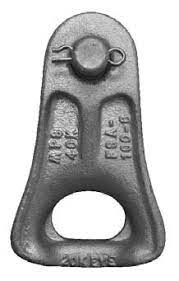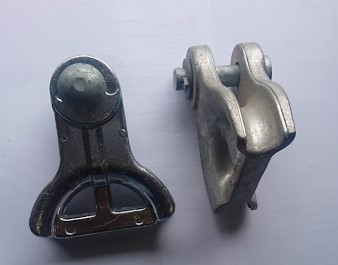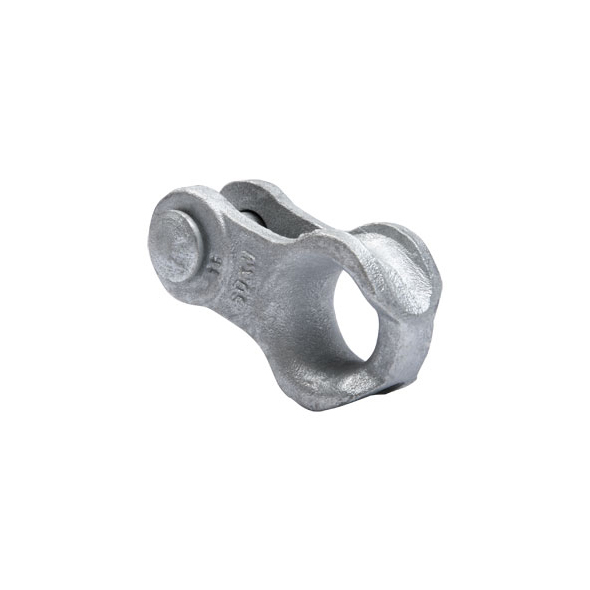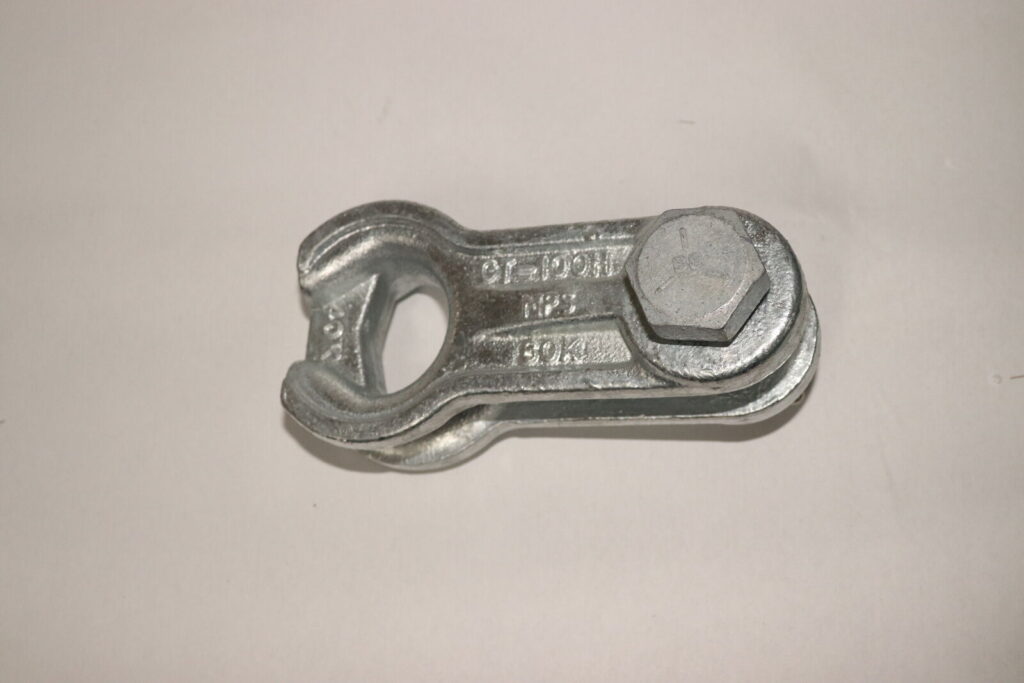
A thimble clevis is a component used in electrical installations to connect conductors to insulators. It has a specific shape that allows them to hold the ends of electrical conductors. It has a cylindrical body with a loop at one end and a clevis at the other end. This design allows the clevises to attach to insulators and accommodate the attachment of shackles. Thimble clevises have designs to withstand high mechanical loads. This is including tension and compression forces. They also have the strength and resilience to support the weight of conductors. The clevises are from high strength materials that provide the necessary durability and load-bearing capacity. Common materials include forged steel or malleable iron. Thimble clevises find use in various applications. These include power lines, utility pole installations, telecommunication and distribution systems.
Functions of thimble clevis in overhead transmission lines
Thimble clevises serve important functions in overhead transmission lines. This is by contributing to safety, reliability and efficiency of the electrical infrastructure. They also provide support, attachment and mechanical strength to electrical conductors. The following are the common functions of thimble clevises in overhead transmission lines.

- Conductor support – the clevises hold electrical conductors in place to prevent sagging. This helps provide reliable support and maintain proper alignment of the conductors.
- Mechanical integrity – the clevises play a crucial role in maintaining the mechanical integrity. they are able to withstand high tensile forces exerted on the conductors. This helps distribute the forces along the length of the transmission line to reduce risk of failure.
- Corrosion resistance – clevises are from materials such as steel or iron. These materials offer excellent corrosion resistance properties. This ensures the clevises maintain their structural integrity and performance.
- Attachment to insulators – thimble clevises connect electrical conductors to insulators. This is important for isolating the conductors from the support structures and the ground. The clevis end of the thimble clevis attaches to the insulator hardware to allow for a secure and stable connection.
- Facilitation of line maintenance – the clevises have designs for easy installation and removal during maintenance and repair. They allow for disconnection and reattachment without compromising the integrity of the line.
Properties of thimble clevis
Thimble clevises has several properties that help to ensure their reliability and durability. The various properties of the clevis is important in overhead transmission lines. Additionally, they help to ensure secure attachment and support of electrical conductors. The following are the various properties of thimble clevises.

- Corrosion resistance – the clevises are able to withstand exposure to various environmental elements. This is including moisture, humidity, salt spray and chemical pollutants. They may have protective coatings to prevent corrosion or rust for reliability.
- Dimensional accuracy – thimble clevises come with precise dimensional tolerances. This is to ensure compatibility with other components in the electrical installation. It works with components such as insulators, hardware fittings and attachment points. Accuracy is important for proper alignment, secure attachment and efficient transmission of power.
- Temperature resistance – clevises are capable of withstanding a wide range of temperatures. This is from extreme cold to high heat. This resistance ensures reliable performance in diverse climatic conditions.
- Material composition – the clevises are from high strength materials such as steel iron or aluminum alloy. The materials offer mechanical properties like high tensile strength, toughness and resistance to deformation.
- Load-bearing capacity – thimble clevises have designs to support the weight of electrical conductors. They also allow them to withstand the mechanical forces. This is including tension, compression and bending loads. They also meet industry standards and specifications for load-bearing. This helps to ensure safe and reliable operation.
- Ease of installation – the clevises have designs for easy installation and removal. This is to allow for quick and efficient assembly. They have user-friendly designs with standardized attachment mechanisms like clevis pins, bolts or shackles.
- Fatigue resistance – thimble clevises face repeated loading cycles during operation. Fatigue leads to fatigue failure. The clevises thus have fatigue-resistant designs to ensure long-term reliability and durability.
Community forums and interactions for thimble clevises
There are several platforms to interact with experts and other users about thimble clevises. These forums relate to electrical engineering, power transmission and utility infrastructure. Additionally, it is advisable to consult manufacturers, suppliers or industry experts for more information. The following are the common community forums and interactions for thimble clevises.

- Electrical engineering forums – these are websites focused on electrical engineering and topics. Joining these forums allows you to ask questions, share knowledge and take part in discussions related to thimble clevises.
- LinkedIn groups – there are many groups and communities related to electrical engineering, power transmission and utility infrastructure. They help to gain opportunities to connect with professionals, share insights and take part in discussions about thimble clevises.
- Professional associations – organizations such as IEEE or IEC may offer online forums or discussion boards. They allow members to discuss technical topics related to electrical components.
- Utility industry forums – these are forums and online communities for professionals working in the utility industry. This is including electrical utilities, power companies and infrastructure maintenance organizations. These are great platforms for networking with industry experts and learning from their experiences.
- Online marketplaces – these includes platforms like Alibaba, Amazon or specialized electrical equipment marketplaces. They have sections for discussions or customer reviews related to thimble clevises. They also provide valuable insights and user experiences with specific products.
Thimble clevises that work with preformed guy grip
Thimble clevises work in conjunction with preformed guy grips in overhead transmission lines. they provide a secure attachment point for guy wires for stability. the specific thimble clevises used with preformed guy grips vary depending on various factors. These factors include size and configuration of the guy wire and the design of the preformed guy grip. Thimble clevises used with preformed guy grip should be compatible with the diameter and construction of the guy wire. This is to ensure a proper fit and reliable connection. Thimble clevises for feature a clevis at one end and a loop at the other end. This helps to ensure the attachment of the preformed guy grip and connection to insulators. Additionally, it is advisable to consult industry experts for guidance on the best thimble clevises to use. The following are the factors to consider when selecting thimble clevises for use with preformed guy grip.

- Size and compatibility – the clevises should have sizes matching the diameter of the guy wires. They and dimensions of the preformed guy grip. This is to ensure a secure fit and prevent slippage or detachment during operation.
- Attachment method – clevises should have a compatible attachment method for securing the preformed guy grip. This may include clevis pins, bolts or other hardware designed to provide a secure and reliable connection.
- Material strength – the clevises should be from high-strength materials to withstand the mechanical forces on the guy wire.
- Corrosion resistance – the clevises should have coatings or corrosion-resistant finishes. They help to protect against rust and corrosion. This helps to ensure long term performance and reliability in harsh environmental conditions.
Certifications for thimble clevis
Thimble clevises should comply to various industry standards to performance and quality. Certifications for thimble clevises involve standards and specifications set by regulatory bodies and industry organizations. This is to ensure that the components meet specific safety, quality and performance requirements. Additionally, it is important to ensure the thimble clevises meet the necessary certifications and standards. The following are the certifications associated with thimble clevises.

- ASTM international standard – this develops and publishes standards for various materials, products, systems and services.
- IEC standards – this publishes international standards for electrical and electronic technologies. Thimble clevises must adhere to relevant standards such as those related to the mechanical properties.
- ANSI standards – this oversees the development of standards for various industries in the United States. The clevises should comply to standards related to materials, dimensions and performance requirements.
- ISO certification – this demonstrates the adherence to quality management system standards. This certification ensures the manufacturer maintains process to deliver products that meet customer requirements.
- UL listing – the clevises undergo testing by UL to ensure compliance with safety and performance standards. It also shows the clevises meets specific criteria for safety, reliability and environmental sustainability.
- NEMA standards – this publishes standards and guidelines for electrical equipment and systems. The clevises adhere to NEMA standards applicable to overhead line hardware and accessories.
Frequently asked questions
A thimble clevis is a component used to attach electrical conductors to support structures. Its main role is to provide a stable and reliable connection while accommodating mechanical forces. It also helps maintain the integrity of the electrical infrastructure.
The clevises are from materials such as forged steel, malleable iron or aluminum alloy. The materials offer excellent mechanical properties including high tensile strength and durability.
Consider factors like material strength, corrosion resistance, load-bearing capacity, dimensional accuracy and temperature resistance. Also, consider factors like ease of installation and fatigue resistance of the thimble clevis.